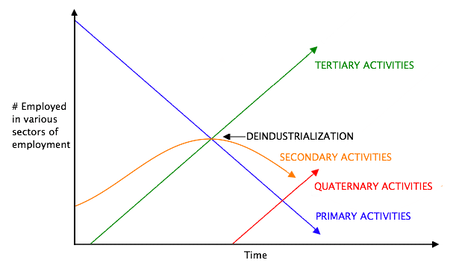Quaternary sector of the economy
The quaternary sector is the label used to describe a knowledge-based[1] part of the economy, which typically includes knowledge-oriented economic sectors such as information technology; media; research and development; information-based services such as information-generation and information-sharing; and knowledge-based services such as consultation, education, financial planning, blogging, and designing.[2]
| Economic sectors |
|---|
| Three-sector model |
|
Primary sector: raw materials Secondary sector: manufacturing Tertiary sector: services |
| Additional sectors |
|
Quaternary sector: information services Quinary sector: human services |
| Theorists |
| AGB Fisher · Colin Clark · Jean Fourastié |
| Sectors by ownership |
| Business sector · Private sector · Public sector · Voluntary sector |
The quaternary sector is based on pure knowledge and skill of a person. It consists of intellectual industries providing information services, such as computing and ICT (information and communication technologies), consultancy (offering advice to businesses) and R&D (research, particularly in scientific fields). According to some definitions, the Quaternary sector includes other pure services, such as the entertainment industry, and the term has been used to describe media, culture, and government.

.jpg)
"Quaternary sector" is a further delineation of the three-sector hypothesis of industry in the sense that the Quaternary sector refers to a part of the third or tertiary sector along with the quinary economic sector. Intellectual services are sometimes regarded as distinct enough to warrant a separate sector and not be considered merely as a part of the tertiary sector. This sector evolves in well-developed countries where the primary and secondary sectors are a minority of the economy, and requires a highly educated workforce.[3]
Between them, the tertiary and quaternary sectors form the largest part of the UK economy, employing 76% of the workforce. The number of people who earn their living in these activities is increasing. Companies invest in the Quaternary sector to promote further expansion. It is seen as a way to generate higher margins or returns on investment.[4] Research will be directed into cutting costs, tapping into markets, producing innovative ideas, new production methods and methods of manufacture, among others. To many industries, such as the pharmaceutical industry, the sector is the most valuable because it creates future secondary-sector branded products from which companies may profit.
See also
References
- Tor Selstad (1990). "The rise of the quaternary sector. The regional dimension of wisdom or knowledge-based services in Norway, 1970–1985 - Norsk Geografisk Tidsskrift - Norwegian Journal of Geography - Volume 44, Issue 1". informaworld.
... knowledge-based services ...
- Peter Busch (1967). "Tacit Knowledge in Organizational Learning". Tacit Knowledge in Organizational Learning. Retrieved 2010-06-17.
see page .. The quaternary sector of industry is the sector of industry that involves the intellectual services. That is research, development, and information.
- "ICTs, industry and the new teacher model". Asian Correspondent. 2010-06-17. Archived from the original on July 30, 2012. Retrieved 2015-09-09.
In Australia, the service sector accounts for 70 per cent of the country's economic activity. Within the service sector, however, more intellectual activities such as government, education, culture and media, can be further defined as the 'quaternary' sector of the economy. These activities are typically not measured in monetary value but they significantly contribute to the economy.
- press release (February 19, 2010). "TEXT-Fitch: Investment to increase in India's healthcare sector". Reuters. Retrieved 2015-07-23.
Fitch notes that newly commissioned hospitals and improved occupancy rates at existing ones will drive revenue growth. Better capacity utilisation and increased focus on higher-margin tertiary and quaternary healthcare services are expected to boost profitability, and improve cash flow from operations (CFO).